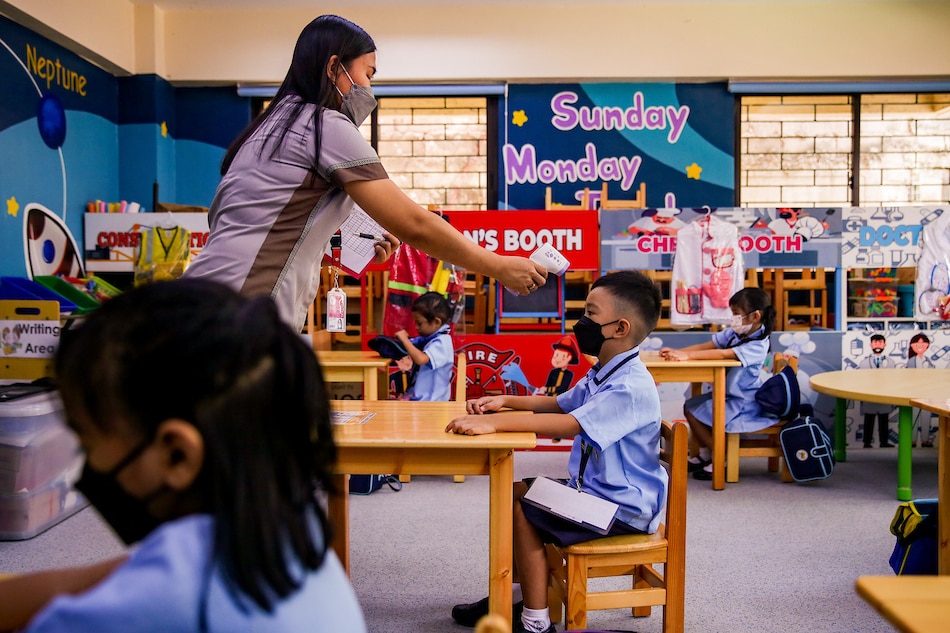Less than 15 pct of Filipino kids can read simple text at age 10: UNICEF
ADVERTISEMENT

Welcome, Kapamilya! We use cookies to improve your browsing experience. Continuing to use this site means you agree to our use of cookies. Tell me more!
Less than 15 pct of Filipino kids can read simple text at age 10: UNICEF
Jaehwa Bernardo,
ABS-CBN News
Published Apr 04, 2022 02:04 PM PHT
|
Updated Apr 04, 2022 08:28 PM PHT
MANILA — Less than 15 percent of Filipino children can read a simple text at age 10, a recent report from the United Nations Children's Fund (UNICEF) said, prompting a lawmaker to urge the government to open all schools in the country for limited in-person classes.
MANILA — Less than 15 percent of Filipino children can read a simple text at age 10, a recent report from the United Nations Children's Fund (UNICEF) said, prompting a lawmaker to urge the government to open all schools in the country for limited in-person classes.
The finding in the UNICEF's latest joint report with the United Nations Educational, Scientific and Cultural Organization (UNESCO) and World Bank "translates to a learning poverty of more than 85 percent," said Senate Basic Education Committee Chairman Sherwin Gatchalian.
The finding in the UNICEF's latest joint report with the United Nations Educational, Scientific and Cultural Organization (UNESCO) and World Bank "translates to a learning poverty of more than 85 percent," said Senate Basic Education Committee Chairman Sherwin Gatchalian.
The figure is slightly lower than the 90 percent learning poverty reported by the World Bank last November.
The figure is slightly lower than the 90 percent learning poverty reported by the World Bank last November.
The World Bank defines learning poverty as the inability of a child to "read and understand simple text by age 10."
The World Bank defines learning poverty as the inability of a child to "read and understand simple text by age 10."
ADVERTISEMENT
The UNICEF report titled "Where Are We On Education Recovery?" also found that the Philippines had the longest pandemic school closure among 122 countries, at 70 weeks.
The UNICEF report titled "Where Are We On Education Recovery?" also found that the Philippines had the longest pandemic school closure among 122 countries, at 70 weeks.
Neighboring countries Cambodia and Myanmar also had less than 15 percent of their children capable of reading a simple text at age 10, even though they had shorter periods of school closures, according to the report.
Neighboring countries Cambodia and Myanmar also had less than 15 percent of their children capable of reading a simple text at age 10, even though they had shorter periods of school closures, according to the report.
Afghanistan, Chad, the Democratic Republic of Congo, Ethiopia, Gambia and Mozambique yielded similar results, based on the report.
Afghanistan, Chad, the Democratic Republic of Congo, Ethiopia, Gambia and Mozambique yielded similar results, based on the report.
UNICEF said even before the COVID-19 pandemic, "more than half of 10-year-olds in low- and middle-income countries were unable to read or comprehend a simple story."
UNICEF said even before the COVID-19 pandemic, "more than half of 10-year-olds in low- and middle-income countries were unable to read or comprehend a simple story."
"Now, that figure is estimated to be as high as 70 percent. This has been exacerbated by 2 years of COVID-19-related school closures, which have deepened education inequality," UNCIEF said.
"Now, that figure is estimated to be as high as 70 percent. This has been exacerbated by 2 years of COVID-19-related school closures, which have deepened education inequality," UNCIEF said.
ADVERTISEMENT
"We know that the most vulnerable children are paying the heaviest price, with evidence of disproportionate learning loss among children from disadvantaged backgrounds, children living in rural areas, children with disabilities and younger students," it said.
"We know that the most vulnerable children are paying the heaviest price, with evidence of disproportionate learning loss among children from disadvantaged backgrounds, children living in rural areas, children with disabilities and younger students," it said.
The humanitarian agency said "2 in 5 learners continue to experience significant disruptions to education" up until the end of February.
The humanitarian agency said "2 in 5 learners continue to experience significant disruptions to education" up until the end of February.
It cited UNESCO data showing that "while a majority of countries have fully opened schools, 42 countries have opened schools partially and six countries have their schools fully closed."
It cited UNESCO data showing that "while a majority of countries have fully opened schools, 42 countries have opened schools partially and six countries have their schools fully closed."
UNICEF warned that "in addition to missed learning, school closures deprive children of the benefits to their safety, health, nutrition and overall wellbeing provided by schools."
UNICEF warned that "in addition to missed learning, school closures deprive children of the benefits to their safety, health, nutrition and overall wellbeing provided by schools."
"School closures also pose long-term economic consequences: the current generation of learners could stand to lose as much as $17 trillion dollars in lifetime earnings in present value as a result of school closures, representing 14 percent of today’s global [gross domestic product]," it added.
"School closures also pose long-term economic consequences: the current generation of learners could stand to lose as much as $17 trillion dollars in lifetime earnings in present value as a result of school closures, representing 14 percent of today’s global [gross domestic product]," it added.
ADVERTISEMENT
To address what it called a learning crisis, UNICEF urged governments to:
To address what it called a learning crisis, UNICEF urged governments to:
- Reach every child and retain them in school
- Assess learning levels
- Prioritize teaching the fundamentals
- Increase catch-up learning and progress beyond what was lost
- Develop psychosocial health and well-being so every child is ready to learn
- Reach every child and retain them in school
- Assess learning levels
- Prioritize teaching the fundamentals
- Increase catch-up learning and progress beyond what was lost
- Develop psychosocial health and well-being so every child is ready to learn
Open more schools
In a statement on Monday, Sen. Gatchalian said all schools in the country should conduct limited in-person classes and that the government should implement a learning recovery program.
In a statement on Monday, Sen. Gatchalian said all schools in the country should conduct limited in-person classes and that the government should implement a learning recovery program.
"Kailangang tutukan natin ang pagbangon ng sektor ng edukasyon upang matiyak na natututo nang husto ang ating mga mag-aaral," said Gatchalian, who is running for reelection in the May 9 elections.
"Kailangang tutukan natin ang pagbangon ng sektor ng edukasyon upang matiyak na natututo nang husto ang ating mga mag-aaral," said Gatchalian, who is running for reelection in the May 9 elections.
(We need to focus on the recovery of our education sector to ensure that our students are learning properly.)
(We need to focus on the recovery of our education sector to ensure that our students are learning properly.)
As of March 28, up to 13,692 public and private schools have opened to limited in-person classes, according to the Department of Education (DepEd).
As of March 28, up to 13,692 public and private schools have opened to limited in-person classes, according to the Department of Education (DepEd).
ADVERTISEMENT
Education Secretary Leonor Briones said the DepEd is "optimistic with this upward trend on the number of schools already implementing classroom-based learning.
Education Secretary Leonor Briones said the DepEd is "optimistic with this upward trend on the number of schools already implementing classroom-based learning.
"With support from the [DepEd's] Central and Regional Offices, we are keen on reintroducing physical classes to more localities in the country," she said in a statement.
"With support from the [DepEd's] Central and Regional Offices, we are keen on reintroducing physical classes to more localities in the country," she said in a statement.
Last week, DepEd officials said they were already developing a learning recovery plan that would help schools address learning gaps caused by the pandemic.
Last week, DepEd officials said they were already developing a learning recovery plan that would help schools address learning gaps caused by the pandemic.
The proposed strategies include extending the school calendar, expanding learning time, establishing learning support centers in schools and community-based learning spaces, conducting summer remediation and intervention programs, and hiring additional learning support aides, among others.
The proposed strategies include extending the school calendar, expanding learning time, establishing learning support centers in schools and community-based learning spaces, conducting summer remediation and intervention programs, and hiring additional learning support aides, among others.
Education Assistant Secretary Alma Torio has said the first phase of the recovery plan would be implemented in the coming summer while the succeeding stages will be in the next school years.
Education Assistant Secretary Alma Torio has said the first phase of the recovery plan would be implemented in the coming summer while the succeeding stages will be in the next school years.
RELATED VIDEO
Read More:
education
basic education
learning poverty
reading
UNICEF
UNESCO
World Bank
Sherwin Gatchalian
Department of Education
learning recovery
ADVERTISEMENT
ADVERTISEMENT




